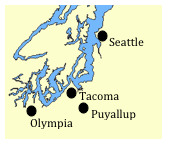Example
A group of mathematicians are getting together for a conference. The members are coming from four cities: Seattle, Tacoma, Puyallup, and Olympia. Their approximate locations on a map are shown below.

The votes for where to hold the conference were:
|
51 |
25 |
10 |
14 |
| 1st choice |
Seattle |
Tacoma |
Puyallup |
Olympia |
| 2nd choice |
Tacoma |
Puyallup |
Tacoma |
Tacoma |
| 3rd choice |
Olympia |
Olympia |
Olympia |
Puyallup |
| 4th choice |
Puyallup |
Seattle |
Seattle |
Seattle |
Use the Borda count method to determine the winning town for the conference.
Answer:
In each of the 51 ballots ranking Seattle first, Puyallup will be given 1 point, Olympia 2 points, Tacoma 3 points, and Seattle 4 points. Multiplying the points per vote times the number of votes allows us to calculate points awarded
|
51 |
25 |
10 |
14 |
| 1st choice 4 points |
Seattle
[latex]4\cdot51=204[/latex] |
Tacoma
[latex]4\cdot25=100[/latex] |
Puyallup
[latex]4\cot10=40[/latex] |
Olympia
[latex]4\cdot14=56[/latex] |
| 2nd choice 3 points |
Tacoma
[latex]3\cdot51=153[/latex] |
Puyallup
[latex]3\cdot25=75[/latex] |
Tacoma
[latex]3\cdot10=30[/latex] |
Tacoma
[latex]3\cdot14=42[/latex] |
| 3rd choice 2 points |
Olympia
[latex]2\cdot51=102[/latex] |
Olympia
[latex]2\cdot25=50[/latex] |
Olympia
[latex]2\cdot10=20[/latex] |
Puyallup
[latex]2\cdot14=28[/latex] |
| 4th choice 1 point |
Puyallup
[latex]1\cdot51=51[/latex] |
Seattle
[latex]1\cdot25=25[/latex] |
Seattle
[latex]1\cdot10=10[/latex] |
Seattle
[latex]1\cdot14=14[/latex] |
Adding up the points:
Seattle: [latex]204+25+10+14=253[/latex] points
Tacoma: [latex]153+100+30+42=325[/latex] points
Puyallup: [latex]51+75+40+28=194[/latex] points
Olympia: [latex]102+50+20+56=228[/latex] points
Under the Borda Count method, Tacoma is the winner of this vote.
Here is a video showing the example from above.
https://youtu.be/vfujywLdW_s?list=PL1F887D3B8BF7C297
Try It
Consider again the election from earlier. Find the winner using Borda Count. Since we have some incomplete preference ballots, for simplicity, give every unranked candidate 1 point, the points they would normally get for last place.
|
44 |
14 |
20 |
70 |
22 |
80 |
39 |
| 1st choice |
G |
G |
G |
M |
M |
B |
B |
| 2nd choice |
M |
B |
|
G |
B |
M |
|
| 3rd choice |
B |
M |
|
B |
G |
G |
|
 The votes for where to hold the conference were:
The votes for where to hold the conference were:
